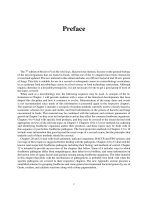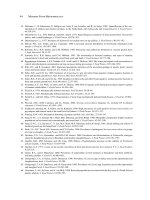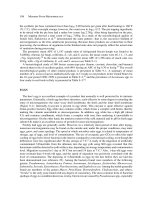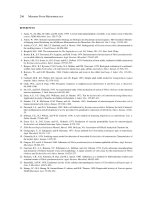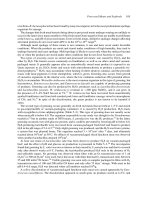Modern food microbiology 7th ed phần 42
Bạn đang xem bản rút gọn của tài liệu. Xem và tải ngay bản đầy đủ của tài liệu tại đây (143.82 KB, 5 trang )
198
Modern Food Microbiology
the synthetic pie base contained fewer than log10 2.00 bacteria per gram after final heating to 160◦ F
(71.1◦ C). After overnight storage, however, the count rose to log10 4.15. The pie topping ingredients
to be mixed with the pie base had a rather low count: log 2.78/g. After being deposited on the pies,
the pie topping showed a total count of log10 7.00/g. In a study of the microbiological quality of
french fries, Surkiewicz et al.57 demonstrated the same pattern—that is, the successive buildup of
microorganisms as the fries underwent processing. Because these products are cooked late in their
processing, the incidence of organisms in the finished state does not properly reflect the actual state
of sanitation during processing.
The geometric mean APC of 1,187 sample units of refrigerated biscuit dough was found to be
34,000/g, whereas for fungi, coliforms, E. coli, and S. aureus, the mean counts were 46, 11, <3, and
<3/g, respectively.58 In the same study, the geometric mean APC of 1,396 units of snack cake was
910/g, with <3/g of coliforms, E. coli, and S. aureus (see Table 9–1).
A bacteriological study of 580 frozen cream-type pies (lemon, coconut, chocolate, and banana)
showed them to be of excellent quality, with 98% having an APC of log 4.70 or less/g.33 The overall
microbiological quality of other related products is presented in Table 9–1. A summary of mean
numbers of L. monocytogenes andSalmonella spp. in 11 ready-to-eat products in the United States for
the 10-year period 1990–1999 is presented in Table 9–2,35 and the prevalence of Aeromonas spp. in
four ready-to-eat foods in Italy is presented in Table 9–3.62
EGGS
The hen’s egg is an excellent example of a product that normally is well protected by its intrinsic
parameters. Externally, a fresh egg has three structures, each effective to some degree in retarding the
entry of microorganisms: the outer waxy shell membrane; the shell; and the inner shell membrane
(Figure 9–1). Internally, lysozyme is present in egg white. This enzyme is quite effective against
Gram-positive bacteria. Egg white also contains avidin, which forms a complex with biotin, thereby
making this vitamin unavailable to microorganisms. In addition, egg white has a high pH (about
9.3) and contains conalbumin, which forms a complex with iron, thus rendering it unavailable to
microorganisms. On the other hand, the nutrient content of the yolk material and its pH in fresh eggs
(about 6.8) make it an excellent source of growth for most microorganisms.
Freshly laid eggs are generally sterile. However, in a relatively short period of time after laying,
numerous microorganisms may be found on the outside and, under the proper conditions, may enter
eggs, grow, and cause spoilage. The speed at which microbes enter eggs is related to temperature of
storage, age of eggs, and level of contamination. The use of cryogenic gas (CO2 ) to effect the rapid
cooling of eggs led to fewer bacteria in the interior compared to conventional cooling, even though the
differences were less significant after 30-day storage at 7◦ C.8 A study of the migration of artificially
contaminated S.Enteritidis from the albumen into the egg yolk using 860 eggs revealed that this
bacterium could be detected in yolk within a day, depending on storage temperature and contamination
level. Migration occurred in 1 day at 30◦ C but not until 14 days at 7◦ C.2 Also, 1-day-old eggs were
more resistant than 4-week-old eggs, and the speed of migration was positively correlated with the
level of contamination. The deposing of S.Enteritidis in eggs by the hen before they are laid has
been demonstrated (see reference 22). Among the bacteria found were members of the following
genera: Pseudomonas, Acinetobacter, Proteus, Aeromonas, Alcaligenes, Escherichia, Micrococcus,
Salmonella, Serratia, Enterobacter, Flavobacterium, and Staphylococcus. Among the molds generally
found are members of the genera Mucor, Penicillium, Hormodendron, Cladosporium, and others;
“Torula” is the only yeast found with any degree of consistency. The most common form of bacterial
spoilage of eggs is a condition known as rotting. Green rots are caused by Pseudomonas spp., especially
Miscellaneous Food Products
199
Table 9–1 General Microbiological Quality of Miscellaneous Food Products
Products
Frozen cream-type pies
Frozen breaded onion rings
(pre- or partially cooked)
Frozen tuna pot pies
Tofu (commercial)
No. of
Samples
465
465
465
465
465
465
Microbial Group/Target
APC: ≤104 /g
Fungi: 103 /g or less
Coliforms: <10/g
E. coli: 10/g or less
S. aureus: <25/g
0 salmonellae
% Samples
Meeting
Target
Reference
96
98
89
99
99
100
60
60
60
60
60
60
1,590
1,590
1,590
1,590
APC 30◦ C: 105 /g or less
MPN coliforms: <3/g
MPN E. coli: <3/g
MPN S. aureus: <10/g
99
89
99
99.6
66
66
66
66
1,290
1,290
1,290
1,290
APC 30◦ C: 105 /g or less
MPN coliforms: 64/g or less
MPN E. coli: <3/g
MPN S. aureus: <10/g
97.6
93
97
98
66
66
66
66
60
60
60
60
APC: >106 /g
Psychrotrophs: <104 /g
Coliforms: <103 /g
S. aureus: <10/g
83
83
67
100
50
50
50
50
Dry food-grade gelatin
185
APC: 3.00∗ or less/g
74
33
Delicatessen salads
764
Within Army and Air Force
Exchange Service
microbial limits
APC: 5.00∗ or less/g
Coliforms: 1.00∗ or less/g
Yeasts and molds: 1.30∗
or less/g
“Fecal streptococci”: 1.00∗ /g
Presence of S. aureus
Pres. of C. perfringens;
salmonellae
APC: 5.00∗ or less/g
Coliforms: 2.00∗ or less/g
S. aureus: 2.00∗ or less/g
44
12
84
78
55
12
12
12
77
9
0
12
12
12
26–85
36–79
96–100
44
44
44
764
764
764
764
764
764
517
517
517
Retail trade salads
53
53
53
APC: >6.00∗ /g
Coliforms: 2.00∗ or less/g
Presence of S. aureus
36
57
39
6
6
6
Retail trade sandwiches
62
62
62
APC: >6.00∗ /g
Coliforms: >3.00∗ /g
Presence of S. aureus
16
12
60
6
6
6
APC: 6.00∗ or less/g
Spores: 6.00∗ or less/g
Yeasts/molds: 5.00∗ or less/g
73
75
97
23
23
23
Imported spices and herbs
113
114
113
(continues)
200
Modern Food Microbiology
Table 9–1 (continued)
Products
No. of
Samples Microbial Group/Target
% Samples
Meeting
Target
Reference
114
114
TA spores: 3.00∗ or less/g
Pres. of E. coli, S. aureus,
salmonellae
70
0
23
23
Processed spices
114
114
114
114
114
110
APC: 5.00∗ or less/g
APC: 6.00 or less/g
Coliforms: 2.00∗ or less/g
Yeasts/ molds: 4.00∗ or less/g
C. perfringens: <2.00∗ /g
Presence of B. cereus
70
91
97
96
89
53
49
49
49
49
49
48
Dehydrated space foods
129
129
129
102
104
104
APC: <4.00∗ /g
Coliforms: <1/g
E. coli: negative in 1 g
“Fecal streptococci”: 1.30∗ /g
S. aureus: negative in 5 g
Salmonellae: negative in 10 g
93
98
99
88
100
98
47
47
47
47
47
47
Ready-to-eat salad
vegetablesa
2,950
Listeria spp. , 4%; L. monocytogenes,
3% (102 in only one)
51
RTE foods, U.K.
4,469
Campylobacter = 0
39
L. monocytogenes = 2.9%
55
Various restaurant
foods—Spain
103
Note: APC = aerobic plate count; MPN = most probable number.
a Negative
∗ log
10
for Campylobacter spp., E. coli 0157:H7, and Salmonella spp.
numbers.
Table 9–2 Mean Prevalence of Listeria monocytogenes and Salmonella Species in Seven
Ready-to-Eat Meat/Poultry Products in the United States for the 10-Year Period 1990–1999.35
Number of Foods Positive/Number Tested/Percent Positive.
Products
Cooked, roast, corned beef
Sliced ham, luncheon meats
Small cooked sausages
Large cooked sausages
Jerky
Cooked poultry products
Salads, spreads, pates
´
L. monocytogenes
Salmonella
163/5,272/3.1
118/2,287/5.2
243/6,820/3.6
56/4,262/1.3
4/770/0.5
145/6,836/2.1
119/3,932/3.0
12/5,444/0.2
5/2,293/0.2
14/6,996/0.2
3/4,328/0.07
2/648/0.3
7/7,020/0.1
2/4,204/0.05
Miscellaneous Food Products
201
Table 9–3 Summary of Aeromonas spp. in Ready-to-Eat Foods in Naples, Italy62
Products
Vegetablesa
Cheesesa
Meat productsa
Ice cream
a Five
Number
Percent
Positive
A. hydrophila
Isolates
A. caviae
Isolates
A. sobria
Isolates
100
100
100
20
25
10
11
0
11
6
10
0
15
5
3
0
0
1
0
0
different products included.
P. fluorescens; colorless rots by Pseudomonas, Acinetobacter, and other species; black rots by Proteus,
Pseudomonas, and Aeromonas; pink rots by Pseudomonas; red rots by Serratia spp., and “custard”
rots by Proteus vulgaris and P. intermedium. Mold spoilage of eggs is generally referred to as pinspots,
from the appearance of mycelial growth on the inside upon candling. Penicillium andCladosporium
spp. are among the most common causes of pinspots and fungal rotting in eggs. Bacteria also cause a
condition in eggs known as mustiness. Pseudomonas graveolens and Proteus spp. have been implicated
in this condition, with P. graveolens producing the most characteristic spoilage pattern.
The entry of microorganisms into whole eggs is favored by high humidity. Under such conditions,
growth of microorganisms on the surface of eggs is favored, followed by penetration through the shell
and inner membrane. The latter structure is the most important barrier to the penetration of bacteria
into eggs, followed by the shell and the outer membrane.36 More bacteria are found in egg yolk than
in egg white, and the reason for a general lack of microorganisms in egg white is quite possibly its
content of antimicrobial substances. In addition, upon storage, the thick white loses water to the yolk,
resulting in a thinning of yolk and a shrinking of the thick white. This phenomenon makes it possible
for the yolk to come into direct contact with the inner membrane, where it may be infected directly by
Figure 9–1 Structure of the hen’s egg as shown by a section through the long axis. Source: From Brooks and
Hale,3 reproduced with permission from Elsevier Publishing Co.
202
Modern Food Microbiology
microorganisms. Once inside the yolk, bacteria apparently grow in this nutritious medium, producing
byproducts of protein and amino acid metabolism such as H2 S and other foul-smelling compounds.
The effect of significant growth is to cause the yolk to become “runny” and discolored. Molds generally
multiply first in the region of the air sac, where oxygen favors growth of these forms. Under conditions
of high humidity, molds may be seen growing over the outer surface of eggs. Under conditions of low
humidity and low temperatures, surface growth is not favored, but eggs lose water at a faster rate and
thereby become undesirable as products of commerce.
The antimicrobial systems of eggs are noted in Chapter 3. In addition, hen egg albumen contains
ovotransferrin, which chelates metal ions, particularly Fe3+ , and ovoflavoprotein, which binds riboflavin. At its normal pH of 9.0–10.0, egg albumen is cidal to Gram-positive bacteria and yeasts at
both 30◦ C and 39.5◦ C.61 The addition of iron reduces the antimicrobial properties of egg albumen.
In regards to the destruction of salmonellae in boiled shell eggs, it is generally recognized that
cooking until the entire yolk is solidified is sufficient to destroy S. enterica serotype Enteritidis. In one
study, boiling for 7 minutes destroyed 108 cfu of artifically inoculated S. Typhimurium.1 In another
study, the American Egg Board method of heating to 100◦ C, removing from heat, and holding for 15
minutes was found to be better than two other methods tested.5 The recommended handling of fresh
eggs to prevent salmonellosis is presented in Chapter 26.
MAYONNAISE AND SALAD DRESSING
Mayonnaise can be defined as a semisolid emulsion of edible vegetable oil, egg yolk or whole egg,
vinegar, and/or lemon juice, and other ingredients such as salt and other seasonings and glucose, in a
finished product containing not less than 50% edible oil. The pH of this product ranges from 3.6 to 4.0,
with acetic acid as the predominant acid, representing 0.29–0.5% of total product (aqueous phase up
to 2%) with a water activity (aw ) of 0.925. The aqueous phase contains 9–11% salt and 7–10% sugar.53
Salad dressings are quite similar in composition to mayonnaise, but the finished product contains at
least 30% edible vegetable oil and has an aw of 0.929, a pH of 3.2 to 3.9, with acetic acid usually
the predominant acid accounting for 0.9 to 1.2% of total product. The aqueous phase contains 3.0 to
4.0% salt and 20 to 30% sugar.53 Although the nutrient content of these products is suitable as food
sources for many spoilage organisms, the pH, organic acids, and low aw restrict spoilers to yeasts, a
few bacteria, and molds. The yeast Zygosaccharomyces bailii is known to cause the spoilage of salad
dressings, tomato catsup, carbonated beverages, and some wines. Yeasts of the genus Saccharomyces
have been implicated in the spoilage of mayonnaise, salad dressing, and French dressing. The two main
spoilers for these products are Lactobacillus fructivorans and Z. bailii. In the spoilage of mayonnaise,
Z. bailii produces product separation and a “yeasty” odor. In one study, the shelf-life of mayonnaise
was extended by the addition of encapsulated cells of Bifidobacterium bifidum and B. infantis.27 With
the addition of nearly 107 cfu/g of the bifidobacteria, yeasts and molds were delayed for about 12
weeks compared to uninoculated controls; and the sensory quality of the preparation was improved
by the bifidobacteria. Another spoilage organism is Lactobacillus brevis subsp. lindneri. Growth of
the latter in buttermilk ranch dressing at pH 3.8–4.2 was inhibited by 200-ppm nisin over a 90-day
incubation period.41
Bacillus vulgatus has been recovered from spoiled Thousand Island dressing, where it caused
darkening and separation of the emulsion. In one study of the spoilage of Thousand Island dressing,
pepper and paprika were shown to be the sources of B. vulgatus.46 Mold spoilage of products of this
type occurs only at the surfaces when sufficient oxygen is available. Separation of the emulsion is
generally one of the first signs of spoilage of these products, although bubbles of gas and the rancid

